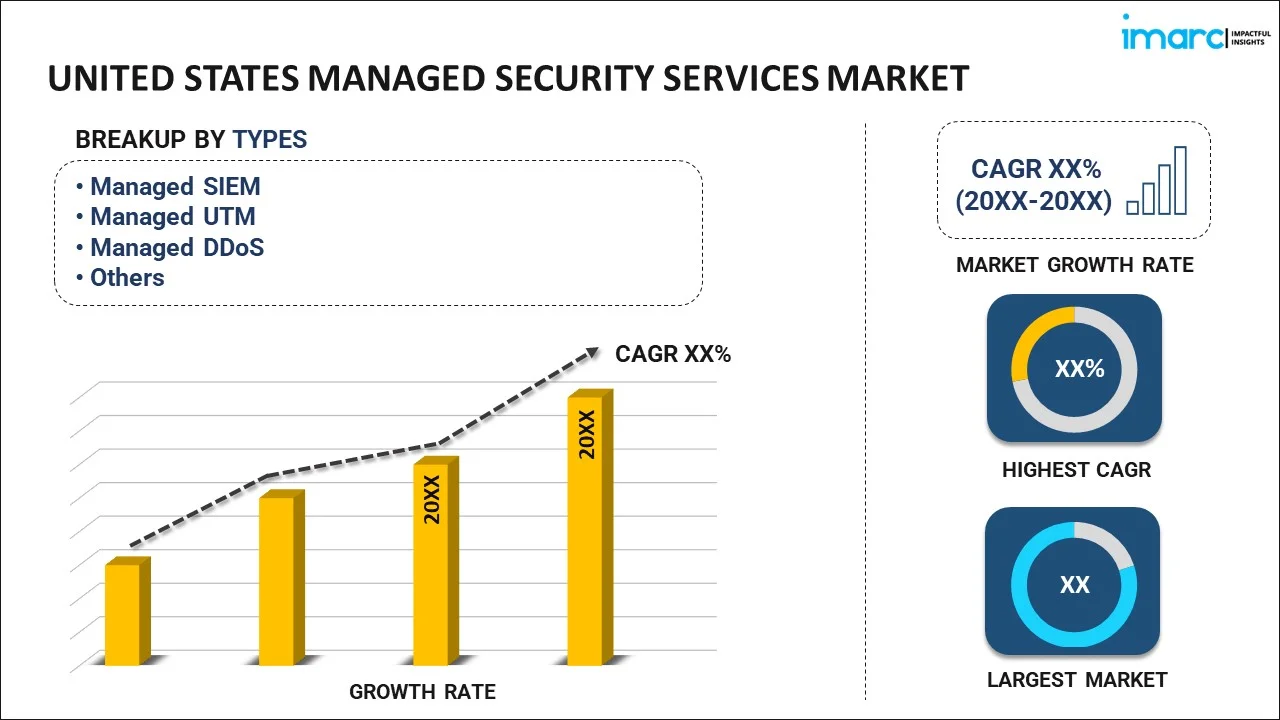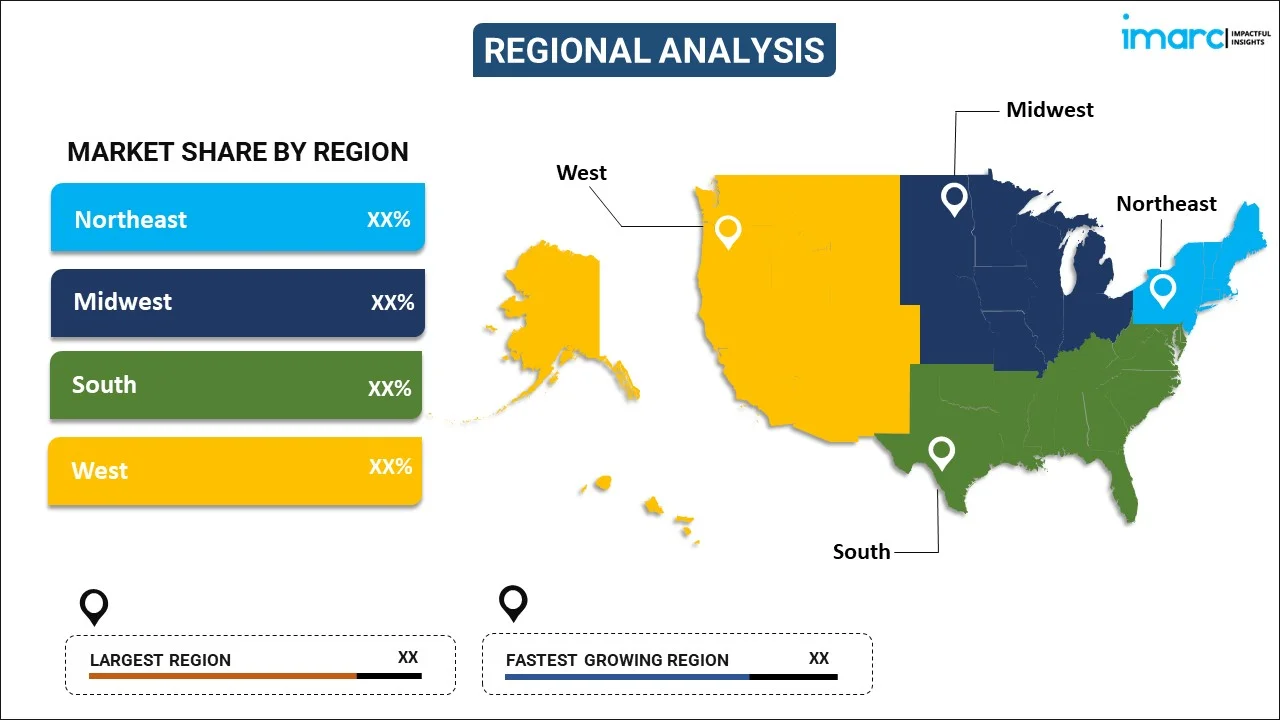
United States Managed Security Services Market Report by Type (Managed SIEM, Managed UTM, Managed DDoS, Managed XDR, Managed IAM, Managed Risk and Compliance, and Others), Deployment Mode (On-premises, Cloud-based), Enterprises Size (Small and Medium-Sized Enterprises, Large Enterprises), Vertical (BFSI, Healthcare, Manufacturing, IT and Telecom, Retail, Defense/Government, and Others), and Region 2025-2033
Market Overview:
United States managed security services market size reached USD 7.8 Billion in 2024. Looking forward, IMARC Group expects the market to reach USD 29.7 Billion by 2033, exhibiting a growth rate (CAGR) of 15.9% during 2025-2033. The ever-growing sophistication and frequency of cyber threats, including ransomware, data breaches, and advanced persistent threats, which lead organizations to seek expert security services, is driving the market.
|
Report Attribute
|
Key Statistics
|
|---|---|
|
Base Year
|
2024 |
|
Forecast Years
|
2025-2033
|
|
Historical Years
|
2019-2024
|
| Market Size in 2024 | USD 7.8 Billion |
| Market Forecast in 2033 | USD 29.7 Billion |
| Market Growth Rate (2025-2033) | 15.9% |
Managed security services (MSS) refers to the outsourcing of an organization's cybersecurity management to a third-party service provider. These services encompass a range of activities designed to protect digital assets and sensitive information from cyber threats. MSS typically includes continuous monitoring, threat detection, incident response, and vulnerability management. Service providers employ advanced technologies and expertise to identify and mitigate potential security risks, ensuring a proactive and adaptive defense against evolving cyber threats. MSS also often involves round-the-clock security operations, allowing organizations to benefit from real-time threat intelligence and response capabilities. By outsourcing security management, businesses can leverage the specialized skills of MSS providers, enhance their overall cybersecurity posture, and focus on core operations, thus reducing the burden of maintaining an in-house security infrastructure. This approach enables organizations to stay resilient in the face of an ever-changing threat landscape.
United States Managed Security Services Market Trends:
The managed security services market in the United States is experiencing robust growth, driven by several key factors. Firstly, the escalating frequency and sophistication of cyber threats have compelled organizations to seek comprehensive security solutions. As cyberattacks evolve, MSS providers offer specialized expertise and advanced technologies to proactively detect and mitigate threats, addressing the dynamic nature of the cybersecurity landscape. Moreover, the regional shift towards remote work has accelerated the demand for MSS as organizations prioritize securing distributed networks and endpoints. This trend is further underscored by the increasing adoption of cloud services, necessitating MSS to safeguard cloud-based infrastructures and applications. Consequently, MSS providers play a pivotal role in enabling organizations to navigate the complexities of digital transformation securely. Additionally, regulatory compliance requirements are serving as a driving force for the MSS market. Organizations across various industries must adhere to stringent data protection regulations, necessitating robust security measures. MSS providers offer tailored solutions to ensure compliance, alleviating the burden on organizations to manage intricate regulatory landscapes independently. In conclusion, the regional MSS market is thriving due to the intertwined dynamics of evolving cyber threats, the proliferation of remote work, cloud adoption, and the imperative for regulatory compliance, positioning MSS as a critical component of modern cybersecurity strategies.
United States Managed Security Services Market Segmentation:
IMARC Group provides an analysis of the key trends in each segment of the market, along with forecasts at the country level for 2025-2033. Our report has categorized the market based on type, deployment mode, enterprises size, and vertical.
Type Insights:

- Managed SIEM
- Managed UTM
- Managed DDoS
- Managed XDR
- Managed IAM
- Managed Risk and Compliance
- Others
The report has provided a detailed breakup and analysis of the market based on the type. This includes managed SIEM, managed UTM, managed DDoS, managed XDR, managed IAM, managed risk and compliance, and others.
Deployment Mode Insights:
- On-premises
- Cloud-based
A detailed breakup and analysis of the market based on deployment mode have also been provided in the report. This includes on-premises and cloud-based.
Enterprises Size Insights:
- Small and Medium-Sized Enterprises
- Large Enterprises
The report has provided a detailed breakup and analysis of the market based on the enterprises size. This includes small and medium-sized enterprises and large enterprises.
Vertical Insights:
- BFSI
- Healthcare
- Manufacturing
- IT and Telecom
- Retail
- Defense/Government
- Others
A detailed breakup and analysis of the market based on vertical have also been provided in the report. This includes BFSI, healthcare, manufacturing, IT and telecom, retail, defense/government, and others.
Regional Insights:

- Northeast
- Midwest
- South
- West
The report has also provided a comprehensive analysis of all the major regional markets, which include the Northeast, Midwest, South, and West.
Competitive Landscape:
The market research report has also provided a comprehensive analysis of the competitive landscape in the market. Competitive analysis such as market structure, key player positioning, top winning strategies, competitive dashboard, and company evaluation quadrant has been covered in the report. Also, detailed profiles of all major companies have been provided.
United States Managed Security Services Market Report Coverage:
| Report Features | Details |
|---|---|
| Base Year of the Analysis | 2024 |
| Historical Period | 2019-2024 |
| Forecast Period | 2025-2033 |
| Units | Billion USD |
| Scope of the Report | Exploration of Historical Trends and Market Outlook, Industry Catalysts and Challenges, Segment-Wise Historical and Future Market Assessment:
|
| Types Covered | Managed SIEM, Managed UTM, Managed DDoS, Managed XDR, Managed IAM, Managed Risk and Compliance, Others |
| Deployment Modes Covered | On-premises, Cloud-based |
| Enterprises Sizes Covered | Small and Medium-Sized Enterprises, Large Enterprises |
| Verticals Covered | BFSI, Healthcare, Manufacturing, IT and Telecom, Retail, Defense/Government, Others |
| Regions Covered | Northeast, Midwest, South, West |
| Customization Scope | 10% Free Customization |
| Post-Sale Analyst Support | 10-12 Weeks |
| Delivery Format | PDF and Excel through Email (We can also provide the editable version of the report in PPT/Word format on special request) |
Key Questions Answered in This Report:
- How has the United States managed security services market performed so far and how will it perform in the coming years?
- What has been the impact of COVID-19 on the United States managed security services market?
- What is the breakup of the United States managed security services market on the basis of type?
- What is the breakup of the United States managed security services market on the basis of deployment mode?
- What is the breakup of the United States managed security services market on the basis of enterprises size?
- What is the breakup of the United States managed security services market on the basis of vertical?
- What are the various stages in the value chain of the United States managed security services market?
- What are the key driving factors and challenges in the United States managed security services?
- What is the structure of the United States managed security services market and who are the key players?
- What is the degree of competition in the United States managed security services market?
Key Benefits for Stakeholders:
- IMARC’s industry report offers a comprehensive quantitative analysis of various market segments, historical and current market trends, market forecasts, and dynamics of the United States managed security services market from 2019-2033.
- The research report provides the latest information on the market drivers, challenges, and opportunities in the United States managed security services market.
- Porter's five forces analysis assist stakeholders in assessing the impact of new entrants, competitive rivalry, supplier power, buyer power, and the threat of substitution. It helps stakeholders to analyze the level of competition within the United States managed security services industry and its attractiveness.
- A competitive landscape allows stakeholders to understand their competitive environment and provides an insight into the current positions of key players in the market.
Need more help?
- Speak to our experienced analysts for insights on the current market scenarios.
- Include additional segments and countries to customize the report as per your requirement.
- Gain an unparalleled competitive advantage in your domain by understanding how to utilize the report and positively impacting your operations and revenue.
- For further assistance, please connect with our analysts.
 Request Customization
Request Customization
 Speak to an Analyst
Speak to an Analyst
 Request Brochure
Request Brochure
 Inquire Before Buying
Inquire Before Buying




.webp)




.webp)












